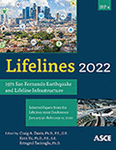Impact of CyberShake on Risk Assessments for Distributed Infrastructure Systems
Publication: Lifelines 2022
ABSTRACT
The Southern California Earthquake Center CyberShake platform was designed as the first probabilistic seismic hazard analysis (PSHA) model using physics-based earthquake simulations. Provided that the simulations have been properly validated, they should, in theory, capture the source, path, and site effects of a specific region. For this work, we build on a recent comprehensive probabilistic seismic risk analysis (PSRA) study of the underground water pipeline network for the City of Los Angeles, where the system-level performance (measured by the expected number of pipeline repairs, repair cost, and repair time) was established as a function of exceedance probability based on a large set of earthquake simulations using empirical ground motion models (GMMs). By repeating this study using the events and ground motions from the CyberShake simulations, we are exploring the impact of this region-specific PSHA models on seismic risk assessments of distributed infrastructure. Our results show that using the same set of earthquake ruptures and pipe fragility models, CyberShake simulations result in significantly lower estimates of system-level risks than those computed from empirical GMMs at relatively long return periods. More specifically, at a 500-year return period, the expected number of pipeline repairs computed from CyberShake is about 26% lower than that from empirical GMMs. At a 2,500-year return period, the reduction reaches 41%. While a reduction was expected, more work is needed to fully understand the sources of these difference.
Get full access to this article
View all available purchase options and get full access to this chapter.
REFERENCES
Abrahamson, N. A., Silva, W. J., and Kamai, R. (2014). Summary of the ASK14 ground motion relation for active crustal regions. Earthquake Spectra 30(3): 1025–1055.
ALA (American Lifeline Alliances). (2001). Seismic Fragility Formulations for Water Systems: Part 1- Guidelines, American Lifeline Alliances, April 2001.
Bijelić, N., Lin, T., and Deierlein, G. G. (2019). Evaluation of Building Collapse Risk and Drift Demands by Nonlinear Structural Analyses Using Conventional Hazard Analysis versus Direct Simulation with CyberShake Seismograms, Bulletin of the Seismological Society of America 109 1812-1828.
Boore, D. M., Stewart, J. P., Seyhan, E., et al. (2014). NGA-West2 equations for predicting PGA, PGV, and 5% damped PSA for shallow crustal earthquakes. Earthquake Spectra 30(3): 1057–1085.
Bozorgnia, Y., Abrahamson, N. A., Al Atik, L., et al. (2014). NGA-West2 Research Project. Earthquake Spectra 30(3): 973–987. DOI: https://doi.org/10.1193/072113EQS209M.
Campbell, K. W., and Bozorgnia, Y. (2014). NGA-West2 ground motion model for the average horizontal components of PGA, PGV, and 5% damped linear acceleration response spectra. Earthquake Spectra 30(3): 1087–1115.
Chiou, B. S.-J., and Youngs, R. R. (2014). Update of the Chiou and Youngs NGA model for the average horizontal component of peak ground motion and response spectra. Earthquake Spectra 30(3): 1117–1153.
Davis, C. A. (2017). Developing a Seismic Resilient Pipe Network Using Performance-Based Seismic Design Procedures. Proc. of 10th Taiwan-Japan-US Workshop on Water System Seismic Practices, WRF/JWWA, Tainan, Taiwan, October 18-20.
Davis, C. (2018). Applying Performance-Based Seismic Design to Create Resilient Lifeline Systems. 11th National Conference on Earthquake Engineering, June 28, 2018, Los Angeles.
Abrahamson, N. A., et al. (2019). Probabilistic Seismic Hazard Analysis in California Using Nonergodic Ground‐Motion Models. Bull. of Seismo. Soc. of Am., 109(4), 1235-1249.
Field, E. H., et al. (2014). Uniform California Earthquake Rupture Forecast, Version 3 (UCERF3) - The Time‐Independent Model; Bull. of the Seismo. Soc. of Am., Vol. 104 (3): 1122-1180, 2014.
Gearhart, J., et al. (2019). Optimization-based Probabilistic Consequence Scenario Construction for Lifeline Systems. Earthquake Spectra, Vol 30, No. 4, 2014.
Graves, R., Jordan, T. H., et al. (2011). CyberShake: A physics-based seismic hazard model for southern California. Pure and Applied Geophysics, 168(3-4), 367-381.
Han, Y., and Davidson, R. A. (2012). Probabilistic seismic hazard analysis for Spatially Distributed infrastructure. Earth. Eng. Struct. Dyn. Vol. 41, No. 15 December 2012 Pages 2141-2158.
Heresi, P., and Miranda, E. (2019). Uncertainty in intraevent spatial correlation of elastic pseudo‑acceleration spectral ordinates. Bull. of Earthq. Eng., 17, 1099–1115 (2019).
Honegger, D. G., and Eguchi, R. T. (1992). Determination of Relative Vulnerabilities to Seismic Damage for San Diego County Water Authority Water Transmission Pipelines.
Jayaram, J., and Baker, J. (2010). Probabilistic Seismic Lifeline Risk Assessment Using Efficient Sampling and Data Reduction Techniques., The John A. Blume Earthquake Engineering Center, Stanford University.
Landwehr, N., Kuehn, N. M., Scheffer, T., and Abrahamson, N. (2016). A nonergodic ground‐motion model for California with spatially varying coefficients. Bull. of Seismo. Soc. of Am., 106(6), 2574-2583.
Lee, Y. (2018). Catastrophe loss modeling through Robust Simulation. Proc., the Eleventh U.S. National Conference on Earth. Eng., June 25-29, 2018, Los Angeles, California.
Lee, Y., Graf, W. P., and Hu, Z. (2018). Characterizing the Logic Tree Distribution in the USGS 2014 National Seismic Hazard Mapping Project (NSHMP). Bull. of Seismo. Soc. of Am., Vol. 108, No. 3A, 1465–1480.
Lee, Y., Hu, J., Harounian, A., Hudson, M. B., Hudson, K. S., Hu, Z., and Eguchi, R. T. (2019). Earthquake Scenario Development for Seismic Performance and Risk Evaluation of the City of Los Angeles Water System Pipeline Network, Proc., the 11th JWWA/WRF/CTWWA Water System Seismic Conference, Los Angeles, October, 2019.
Loth, C., and Baker, J. W. (2013). A spatial cross-correlation model of spectral accelerations at multiple periods. Earth. Eng. Struct. Dyn. 2013; 42:397–417.
Manzour, H., Davidson, R. A., Horspool, N., and Nozick, L. K. (2016). Seismic Hazard and Loss Analysis for Spatially Distributed Infrastructure in Christchurch, New Zealand, Earthquake Spectra, Volume 32, No. 2, pages 697–712, May 2016.
Teng, G., and Baker, J. (2019). Evaluation of SCEC CyberShake Ground Motions for Engineering Practice, Earthquake Spectra 35 1311-1328.
Information & Authors
Information
Published In
History
Published online: Nov 16, 2022
Authors
Metrics & Citations
Metrics
Citations
Download citation
If you have the appropriate software installed, you can download article citation data to the citation manager of your choice. Simply select your manager software from the list below and click Download.
